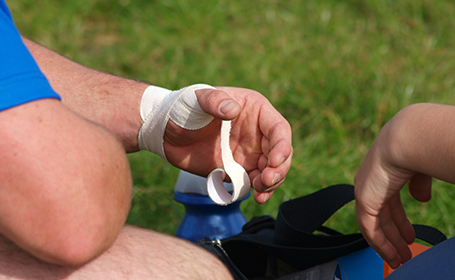
Top 5 common injuries on the rugby field
We explore the top 5 common injuries on the rugby field and consider what you can do to avoid them while you enjoy this high-impact sport. With advice from an expert sports physiotherapist
The upper body, which bears the brunt of the force as players run up against other players, or hit the ground, is unsurprisingly a common site for damage.
As with any sport, you don’t have to be one of the elite players to suffer an injury. Amateur players of all ages are no strangers to the doctors’ surgery, presenting injuries ranging from sprains and strains to more serious dislocations or concussions.
We’re taking a look at five of the most common injuries suffered by rugby players – both professional and amateur – and sharing advice on how to avoid them from sports physiotherapist Daniel Watson, who works with professional rugby players.
1. Concussion

Concussion is a brain injury that can range from mild to severe as a result of the brain being banged against the skull. It has long been the most common injury in Premiership League rugby.
In 2017-18, concussion accounted for 20% of all match injuries.All concussions are serious, and you should not return to play until a medical expert has advised you it is safe to do so. You don’t have to be ‘knocked out’ and lose consciousness to suffer from concussion, so be aware of the warning signs such as headache, memory disturbance, dizziness and problems with balance.
2. Sprains and strains
Caused when muscles or ligaments become overstretched when you stop or start suddenly, change direction, or fall or land awkwardly, sprains and strains are one of the most common of all sports injuries.
With these actions being repeated during a match and in training, it’s little surprise that sprains and strains feature in the list of top rugby injuries. Physiotherapy can help rebuild strength and mobility in overstretched ligaments and muscles, although in severe cases surgery may be required.
3. Dislocated shoulders
Shoulders can become dislocated during a tackle or fall if the arm is rotated outwards. A medical expert should be called to ‘pop’ it back into place, although it is important to also ensure that there are no other associated injuries, such as fractures.
After a period of rest, physiotherapy can effectively rebuild shoulder strength and is essential to help reduce the likelihood of re-injury. Shoulder arthroscopy or other surgery can be carried out on the shoulder to correct more severe damage.
4. Overuse injuries
Overuse injuries such as bursitis (inflammation of the bursa, which acts like a cushion in the shoulder, elbow, knee and ankle joints) and tendonitis (inflammation of a tendon) are commonly seen in rugby players.
Although not as obviously serious as some of the trauma injuries, if left without appropriate remedy from your doctor or physiotherapist they could lead to worse injury, and even reduced mobility, over time.
5. Slipped disc
Contact sports like rugby are high-risk for neck injury such as a slipped disc (cervical disc prolapse). Repeated stress from tackling gradually breaks down the connective tissue around the discs in the neck.
Without this protective tissue, swelling can occur, pressing on nerve endings and resulting in pain. Your spinal surgeon can advise on treatment options, including whether spinal surgery is necessary.
The key concepts you need to understand regarding injury prevention are risk management and preparation.
Preventing injuries on the rugby pitch
Want to play safer and avoid injuries on the pitch? Daniel Watson shares his professional expertise around injury prevention.
Watson has over 10 years’ experience in physiotherapy and sports medicine. He has worked with professional cricketers and ballet dancers as well as rugby players, helping athletes at the top of their game prevent, manage and recover from injuries.
“Injuries are inevitable in a contact sport such as rugby,” explains Watson. “You may be reading this and be one of the few lucky ones to evade the injury ‘jinx‘, but play the game long enough and it will catch up with you. That’s because, unlike an actual jinx, injuries are not purely down to luck.”
He continues: “The key concepts you need to understand regarding injury prevention are risk management and preparation. Understanding these concepts will give you the power to change behaviours and make better decisions.
“I’ll stop short of promising that you will never suffer an injury again. That’s a promise I can’t keep. However, if applied well, these practices should mean that injuries happen less frequently and are often less severe.”
The importance of risk management
“Recognising and identifying risk are the cornerstones of my practice in professional sport. I have found over time that common themes emerge and are of particular importance."
Identifying your personal risk level
To gain an insight into your personal risk level, you should start by answering the following three questions:
- Have you suffered previous injuries?
- Is your training schedule erratic?
- Are you playing beyond your level of current ability?
- If you are answering yes to one or more of these questions then you may be at higher risk of developing an injury compared to someone who answers no to all three.
Controlling these risks
“The good news is that you can absolutely take control and manage these risks.
“If you have suffered an injury, please seek medical attention and ask for help before returning to training. A medical professional will help you assess the damage, begin recovery and decide when it’s time to get back to play.
“Be aware of your training habits and how often you train. Simply tracking this and avoiding significant increases or decreases is going to minimise the likelihood of an injury. This is particularly true for contact-based sessions, which are often very demanding.
“Are you playing at the right level? Is the standard too demanding? You may be a teenager playing with adults, an older statesman playing with younger men or recently invited to play at a higher level.
“If you can’t keep up with play, notice a drop in your skill level or take longer to recover from tackles, consider finding a level that matches your ability, or spend more time on your preparation in order to meet the demands.”
Injury risk is heightened when we play while fatigued... This is due to our muscles producing less power as well as the fact that being tired leads to poorer decision making.
Preparation is key to good play
“A common misconception is that we play sport to get fit. In reality we need to be fit in order to play sport, especially if we are serious about preventing injuries.
“This doesn’t mean you need to spend months preparing yourself like the professionals. Allocating time to developing a basic level of fitness is an important step in preventing injuries.
Depending on your playing position and the code of rugby you play, there may be specific physical requirements that you should focus on and these are best discussed with a professional. However, there are some basic areas that all players can consider as part of their preparation.
Lower limb strength
Lower limb strength is vital for rugby players. It provides power for movement and helps with the stability of commonly-injured joints such as the knee.
“The ability to single leg press over 1.3-1.5 times your body weight is a good indicator of lower limb strength and we often see professionals pressing twice their body weight for one rep,” says Watson. “No leg press machine? No problem. Try single-leg squatting 12-15 times, which is a good indicator of strength endurance.”
Upper body strength
“Upper body strength is so important for absorbing the high impact forces that occur playing rugby.
“Professionals bench press big weights, often exceeding 1.5-2 times their body weight. If you are playing amateur rugby, I would expect you to press your own body weight as a minimum.
“No Bench press? Performing 20-25+ continuous and quality press ups would suggest a good level of upper body strength.”
Aerobic fitness
“Injury risk is heightened when we play while fatigued,” explains Watson. “This is due to our muscles producing less power as well as the fact that being tired leads to poorer decision making. This can result in missed-time tackles or changes in our pattern of movement, placing extra strain on muscles and joints.”
A good level of aerobic fitness reduces the impact of fatigue and therefore reduces the risk of injury.
“Positional demands will dictate your required level of aerobic fitness. However, you can perform a simple running test that we use with the professionals to determine your current level. Our players run a shuttled 1.2km in under 5 minutes. If you are an amateur player, running a straight 1.2km in under 6-7 minutes suggests you have a good baseline.
“Injuries don’t happen purely by chance. Changing behaviours and taking action by preparing well and managing risk can reduce your chances of getting an injury on the rugby pitch. If you are unfortunate enough to suffer an injury, these concepts remain true for when you return to fitness and will provide a firm foundation for long-term fitness and health.”

What to do if you suffer an injury while playing rugby
No matter what level you play at, injuries are an inevitable part of rugby. However, the key to getting back to optimum fitness is knowing exactly how to manage the injury and getting the right treatment at the right time.
At Circle Health Group, our physiotherapists and consultant orthopaedic surgeons are here to help you regain optimum fitness following injury.
Our Sports Injuries Clinics are specialist facilities aimed at professional and amateur sportsmen and women and offer a comprehensive patient-centred service for treatment and rehabilitation using the most up-to-date research based techniques. Call or book online today to start your journey to recovery.
Tags
How do I book an appointment?
If you're concerned about symptoms you're experiencing or require further information on this subject, talk to a GP or see an expert consultant at your local Circle Hospital.